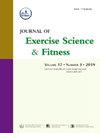Compared to moderate-intensity continuous training, short-term high-intensity interval training demonstrates enhanced effects on metabolic flexibility in adult males with obesity
IF 2.4
2区 医学
Q2 SPORT SCIENCES
引用次数: 0
Abstract
Background
The aim of this study was to assess the effects of short-term high-intensity interval training (HIIT) and moderate-intensity continuous aerobic training (MICT) with matched energy expenditure on metabolic flexibility and other metabolic parameters in adult male individuals with obesity.
Methods
Twenty male individuals with obesity (age: 21.4 ± 1.5 years; body mass index: 31.0 ± 3.6 kg/m2) were enrolled in this crossover design study. Participants were randomly allocated to an intervention sequence of 1) 3 consecutive days of HIIT (30 min, 6 × 2.5 min bouts at 90 % Peak Oxygen Uptake (VO2peak), alternated with 2.5 min active recovery periods [25 % VO2peak]), or 2) three consecutive days of MICT (60 min at 50 % VO2peak), with a washout period of 1 week. Respiratory quotient (RQ), glucose, C-peptide, insulin, and non-esterified fatty acid (NEFA) levels were measured both during fasting and throughout a 180 min oral glucose tolerance test (OGTT), conducted before and after the intervention. The incremental area under the curve (iAUC) and Homeostatic Model Assessment for Insulin Resistance (HOMA-IR) were derived. ΔRQ was defined as the average RQ during the OGTT minus fasting RQ.
Results
Short-term exercise intervention significantly reduced HOMA-IR in male individuals with obesity (P < 0.001) and concurrently increased the Matsuda index (P = 0.001). Both exercise interventions led to a similar decrease in fasting RQ (P = 0.001), C-peptide, insulin, and HOMA-IR (P < 0.001). Additionally, they reduced the iAUC for glucose and insulin during the OGTT (P < 0.001). The ΔRQ and the RQ iAUC in the HIIT group were significantly higher than those in the MICT group, and different exercise intensities exhibited interactive effects within groups for RQ iAUC and ΔRQ (P = 0.013 and P = 0.012).
Conclusions
Two short-term exercise interventions similarly improved glucose tolerance, with HIIT demonstrating a more advantageous effect on metabolic flexibility than MICT in male individuals with obesity.
Trial registration
The trial was officially registered at www.chictr.org.cn (ChiCTR2300072884).
与中等强度的连续训练相比,短期高强度间歇训练对成年肥胖男性代谢灵活性的影响更大
本研究的目的是评估短期高强度间歇训练(HIIT)和中等强度连续有氧训练(MICT)匹配能量消耗对成年男性肥胖个体代谢柔韧性和其他代谢参数的影响。方法男性肥胖患者20例(年龄:21.4±1.5岁;体重指数:31.0±3.6 kg/m2)的患者被纳入这项交叉设计研究。参与者被随机分配到1)连续3天的HIIT(30分钟,6 × 2.5分钟,90%峰值摄氧量),交替进行2.5分钟的活跃恢复期[25%峰值摄氧量]),或2)连续3天的MICT(60分钟,50%峰值摄氧量),洗脱期为1周。呼吸商(RQ)、葡萄糖、c肽、胰岛素和非酯化脂肪酸(NEFA)水平均在禁食期间和干预前后进行的180分钟口服葡萄糖耐量试验(OGTT)中测量。导出了胰岛素抵抗的增量曲线下面积(iAUC)和稳态模型评估(HOMA-IR)。ΔRQ定义为OGTT期间的平均RQ减去禁食RQ。结果短期运动干预可显著降低男性肥胖患者的HOMA-IR (P <;0.001),同时增加了Matsuda指数(P = 0.001)。两种运动干预均导致空腹RQ (P = 0.001)、c肽、胰岛素和HOMA-IR (P <;0.001)。此外,他们还降低了OGTT期间葡萄糖和胰岛素的iAUC (P <;0.001)。HIIT组的ΔRQ和RQ iAUC均显著高于MICT组,组内不同运动强度对RQ iAUC和ΔRQ有交互作用(P = 0.013和P = 0.012)。结论:两种短期运动干预同样改善了葡萄糖耐量,在男性肥胖患者中,HIIT比MICT对代谢灵活性的影响更有利。试验注册该试验已在www.chictr.org.cn (ChiCTR2300072884)上正式注册。
本文章由计算机程序翻译,如有差异,请以英文原文为准。
求助全文
约1分钟内获得全文
求助全文
来源期刊
CiteScore
5.10
自引率
3.60%
发文量
54
审稿时长
31 days
期刊介绍:
The Journal of Exercise Science and Fitness is the official peer-reviewed journal of The Society of Chinese Scholars on Exercise Physiology and Fitness (SCSEPF), the Physical Fitness Association of Hong Kong, China (HKPFA), and the Hong Kong Association of Sports Medicine and Sports Science (HKASMSS). It is published twice a year, in June and December, by Elsevier.
The Journal accepts original investigations, comprehensive reviews, case studies and short communications on current topics in exercise science, physical fitness and physical education.

 求助内容:
求助内容: 应助结果提醒方式:
应助结果提醒方式:


